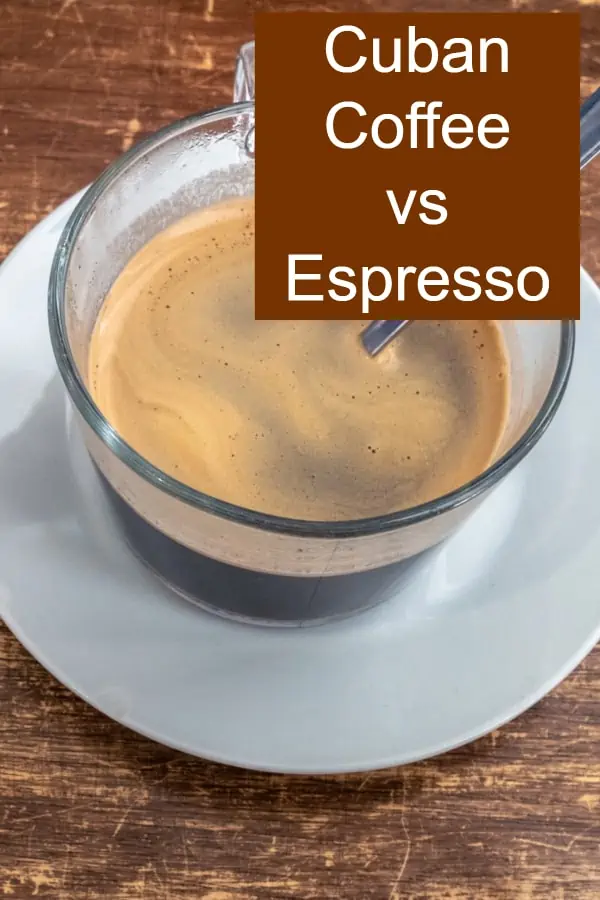Cuban Coffee is known around the world as being strong and delicious. Similarly, Espresso is the first thought that crosses your mind when you think of Italy and Italian coffee.
Both are strong and flavorful. Yet, are they both the same? Are both Cuban coffee and Espresso really just Espresso in a different cup?
Well, not that fast!
They both are technically brewed similarly and a Cuban coffee could and is seen as a type of Espresso. But, their flavor is quite different. You’ll find out more on that further down in the article. Enjoy!

What is Cuban Coffee?
During the 19th and 20th centuries, Cuba was the chief exporter of coffee to Spain. However, when the US embargo on Cuba trade was introduced, trade with Cuba was severely cut off. This caused a decline in Cuban coffee production. In fact, the country’s coffee industry was in a deep funk by the time Fidel Castro came to power.
In Cuba, coffee is served in many ways. It is usually prepared in a Moka pot. Moka pots are typically made of stainless steel or aluminum and brew coffee by steaming water through coffee grounds.
Cuban coffee is a delicious drink that is often topped with sugar. In fact, Cuban coffee has a very interesting history. Its origins go back to 1748 when Jose Antonio Gelabert first brought coffee to Cuba. It is now consumed all over the world.
There are two main types of Cuban coffee. They are the cortado and the cafecito. The cortado is a sweetened shot of Cuban coffee paired with steamed milk. It is the size of a demitasse cup. It is also the traditional method of enjoying Cuban coffee.
The cafecito is a sweetened coffee drink that is similar to a Cuban Latte. It is served in a demitasse cup and consists of three to six sweetened espresso shots. It is usually sweetened with brown sugar. It is similar to the cortado, although it has a slightly less significant caffeine content.
It is often served in Cuban diaspora communities, especially in Latin nations. It is a simple drink to make.

Cuba Coffee Growing Regions
Historically, Cuba has been one of the largest coffee growing regions in the world. In the 1950s, Cuba exported 20,000 tons of coffee around the world. In the next five to ten years, Cuba could produce enough coffee for the U.S. market, according to the Cuban Coffee Association. However, Cuba needs to invest in infrastructure and improve its logistics. In order to make the most of the Cuba coffee growing regions, international coffee companies are helping improve the living conditions of its coffee farmers.
The Sierra Maestra mountains in eastern Cuba are an excellent coffee growing region. The soil is rich in humus and does not require chemical fertilizers. It also has excellent climatic conditions. This type of soil is ideal for growing coffee and produces Arabica and Robusta varieties.
The Cuban coffee industry has been nationalized since the Cuban Revolution in 1959. Today, it is in the hands of international coffee companies, such as The Cuba Mountain Coffee Company, that are helping to revive the coffee industry in Cuba. The company imports and sells premium Cuban coffee into the U.K. and distributes to consumers worldwide. The company works with the Alma de Cuba Coffee Company to provide the U.S. market with premium Cuban coffee, including their Alma de Cuba brand.
Cuba has a rich history with coffee and is currently regaining momentum in the global coffee market. While it is not possible to buy 100% Cuban coffee in the United States, Cuban blends, which are made from beans grown outside of Cuba, are available.
What is Espresso?
Unlike regular coffee, espresso is an Italian style drink that has a strong, bold flavor. Espresso is made with a special machine that uses high pressure to push hot water through a finely ground coffee bean. This creates a concentrated cup.
Espresso is a type of coffee that is usually served in a cup with a capacity of 40 ml. In addition to the coffee, it is also served with a layer of dark golden cream called crema.
The coffee bean is roasted to a dark or medium roast. Generally, a dark roast brings out the full body of the coffee, while a medium roast brings out the light acidity of the bean. It is also well suited for drinking with milk.
In addition to its flavor, espresso is also a good source of antioxidants. Espresso is also low in calories. Coffee aficionados swear by espresso.
The term espresso was coined by Italian inventor Luigi Bezzera. He invented a machine that forced hot water through the coffee, without direct contact between the steam and the coffee. This allowed the coffee to be brewed at a lower temperature.
Unlike drip coffee, espresso is concentrated, making it easier to drink quickly. It is also known to have a rich, toasted flavor.
Espresso is usually served black, but it can also be brewed with milk. Espresso can be served in a cup with a capacity to hold between 25 and 30 ml of coffee.

The History of Espresso in Cuba
During the 18th and 19th centuries, Cuba was one of the biggest coffee exporters in the region. This is because the island was settled by French citizens who brought with them coffee plants. These plantations, along with the brewing technology that they brought, influenced the development of the coffee industry in Cuba.
In the early 1800s, coffee surpassed sugar as the top export of Cuba. During the 19th century, Cuba’s coffee production continued to increase.
In the early 1900s, Cuba’s cafes flourished. These cafes were a meeting place and a cultural symbol. Cubans loved drinking coffee in these cafes. During this period, Havana streets were filled with more than 150 cafes.
However, in the 1960s, Cuba’s cafes were hit hard by the US embargo on Cuba trade. This resulted in Cuba’s coffee production being channeled to the USSR and other communist countries. The Cubans, however, refused to abandon their coffee culture. They preserved their cafes, and began serving Cuban coffee instead of imported espresso.
Cuban espresso is a dark roast that is typically sweetened during the brewing process. It is served in demitasse cups and has a very strong taste. Cubans drink it after meals, in the morning, and during social events.
Coffee has been an important part of Cuba’s economy for hundreds of years. The island is home to several coffee growing regions, including the Sierra Maestro Mountains, which are still handpicked. The most popular varieties are Robusta and Arabica.
Is Cuban Coffee Stronger Than Espresso?
Compared to regular coffee, Cuban coffee is very strong. It has twice the amount of Total Dissolved Solids (TDS), and more caffeine. Cuban coffee is also very sweet, with a very strong flavor.
Cuban coffee is prepared in a special pot called a cafetiere. It uses a single-size filter, which creates a concentrated brew. This is different from the pour-over technique used by most Americans. It also uses a high-pressure steam source, which creates a richer and more potent cup.
Cuban coffee has many similarities to espresso. Both are brewed with finely ground dark-roast beans. However, espresso is also much stronger than Cuban coffee. Despite the fact that espresso contains more caffeine, it is much less sweet.
In contrast, Cuban coffee has a thicker texture and a sweeter taste. This is thanks to a sugar foam called espuma. The foam, which is made by mixing espresso with sugar, is the secret behind the smooth finish of Cuban coffee. Its unique color and taste are also a result of its brewing process.
In Cuba, coffee is a social staple. Many cafes offer a variety of coffee varieties. However, espresso is a popular choice among Cubans.
This is because espresso is made with a strong amount of coffee and a lot of water. Its caffeine content is also high, and it helps reduce idleness. It also stimulates brain activity.
The coffee made in a Moka pot is even stronger than the coffee made in a drip maker. Because the coffee is ground finer, it can be extracted from the beans better.

